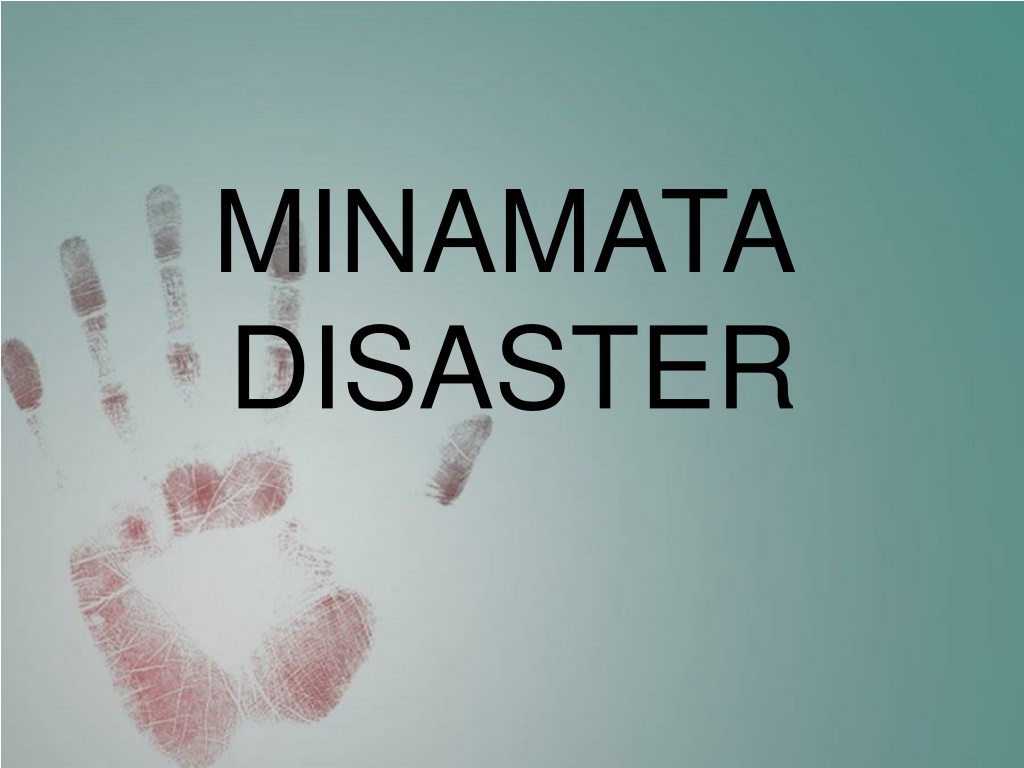The Tragedy of Minamata: A History of Mercury Poisoning
The Minamata Disaster was a tragic event in Japan's history, stemming from mercury poisoning caused by industrial waste disposal. The Chisso Corporation's chemical factory in Minamata released methyl mercury into Minamata Bay, leading to widespread poisoning in humans and animals. The identification of mercury as the root cause, the ensuing compensation battles, the emergence of congenital Minamata Disease, and the long-lasting environmental impact are all key elements of this devastating event.
Download Presentation

Please find below an Image/Link to download the presentation.
The content on the website is provided AS IS for your information and personal use only. It may not be sold, licensed, or shared on other websites without obtaining consent from the author. Download presentation by click this link. If you encounter any issues during the download, it is possible that the publisher has removed the file from their server.
E N D
Presentation Transcript
MINAMATA DISASTER
Outline The History(1908-1955) 1956-1959 Finding the cause/Identification of Mercury 1959 Compensation/waste water treatment Ten years of Silence Congenital Minamata Disease Mercury Poisoning and Control Response Measures against Minamata Pollution Environmental Impact on Minamata Pollution Continued pollution The Water Pollution Control Law Restoration of the Environment
The History(1908-1955) The Chisso Corporation opened a chemical factory in Minamata in 1908. Minamata is a city located Kumamoto prefecture, Japan. Chisso chemical factory initially produced fertilizers. Following the nationwide expansion of Japan s chemical industry, the company branched out into the production of acetylene, acetaldehyde, acetiv acid, vinyl chloride and octanol. The Minamata factory became the most advanced in all of Japan.
The History(1908-1955) The rapid expansion of the Minamata factory spurred on the local economy. Chisso prosperred, so did Minamata. Chisso had great influence on Minamata. In 1932, Chisso Minamata factory first started acetaldehyde production. Producing 210 tons per year. By 1951, production had jumped to 6000 tons per year. Over half of japan s total output.
The History(1908-1955) The chemical reaction used to produce the acetadehyde used mercury sulphate as catalyst. A side reaction of the catalytic cycle led to the production of methyl mercury. Methyl mercury is an organic mercury compound. Methyl mercury is a highly toxic component. Waste water from Chisso factory were released into Minamata Bay.
1956 - 1959 April 21, 1956, a five year old girl was examined at Chisso s factory hospital in Minamata. Physicians were puzzled by her symptoms: Difficulty in walking, speaking and convulsions. Few days later, eight years old girl in the neighbourhood was found experiencing the similar problrms. On May 1, 1956, discovery of an epidemic of unknown disease of the central nervous system was reported to the local public health. Patients were isolated leading to stigmatization and discrimination.
1956 - 1959 Cats were also seen to have convulsions, go mad and die. This disease in cats were commonly called as dancing cat fever. Crows fell from the sky. Fishes floated dead on the sea shore. The Kumamoto University Research Group was formed. The disease developed without prior warning. Patients lost sensation, and complained of numbness in hands and feet. By October, 1956, 40 patients were discovered(14 dead).
1956 - 1959 The researchers figured the following: Staple food of the victims were fish and shellfish from Minamata Bay. Food poisoning by heavy metals. Initially, manganese was thought to be the cause substance. British neurologist Douglas McAlpine suggested the Minamata symptoms resembled to those of organic mercury. Focus of investigation shifted and centered mercury.
1956 - 1959 In February, 1959, mercury distribution in Minamata Bay was investigated. Large quantities of mercury detected in fishes from the bay. The highest concentration centered around the factory wastewater canal in Hyakken harbour.
1956 - 1959 Hair samples of victims and Minamata residents were taken for test. The maximum mercury level recorded was 705 ppm. This compared to to an average level of 4 ppm for non minamata residents.
1959 Chisso came under close scrutiny. In order to deflect criticism, wastewater route was changed. It discharged waste water directly into Minamata river. Now victims began to appear in other fishing villages up and down the coast of the Shirauni Sea.
1959 Chisso did not co-operate with the Kumamoto Research Team. Withheld information on its industrial processes. Chisso factory s hospital director, Hajime Hosokawa carried out his own experiment on Minamata disease. He confirmed that it was organic mercury poisoning. The company did not reveal the result to the investigators. The company orederd Hosokawa to stop the research.
1959 Compensation for fishermen and patients. The agreements were formulated outside the legal system by ad- hoc mediation committees. Final agreements were weighed in favor of Chisso. Punitive clauses in the agreements include: Representative groups of fishermen and Minamata disease patients could not make future claims for compensation against the company .
1959 WASTEWATER TREATMENT SYSTEM On October, 21, Chisso was ordered to switch back its wastewater drainage to Hyakken Harbour. Installed a cyclator purification system with a special ceremony. Chisso s president drank a glass of water supposedly treated to demonstrate it was safe. But wastewater from acetaldehyde plant still contained mercury. Deception that company s wastewater has been made safe. In people s, the issue of Minamata disease was resolved
19591969 Tenyearsofsilence
1959 - 1969 The period between the first set of agreements in 1959 to the first legal action taken against Chisso in 1969 are is called as the Ten years of silence By late 1960, the Kumamoto and Kagoshima perfectural government continued a joint survey in the hairs of the people living around the Shiranui sea. Results showed that organic mercury had spread all around the inland sea.
1959 - 1969 CONTINUED POLLUTION Contaminated fish still poisoned people. 50 ppm of mercury in people s hair were discovered. Highest recorded level was 920 ppm The perfectural government did not publish the results, nor did anything in response to the survey. A follow-up study ten years later discovered that many had died from unknown causes
1959 - 1969 CONGENITAL MINAMATA DISEASE Local doctors noticed for a long time an abnormal high frequency of cerebral palsy. A re-examination of children diagnosed with cerebral palsy was carried out. The symptoms of the children closely mirrored those of adult Minamata disease patients. However, many of their mothers did not exhibit symptoms. After several years of study and autopsy of two children, the doctors diagnosed an unrecognized congenital form of Minamata disease.
1959 - 1969 OFFICIAL GOVERNMENT RECOGNITION On 26 September 1968, the government finally issued an official conclusion as to the cause of Minamata disease. Minamata disease is a disease of t e centralne rvous system, a poisoning caused by long-term consum ption, in large amounts, of fis and s ellfis from MinamataBay.T e causativeagent ismet ylmercury. Met ylm ercury produce d in t e acetalde yde acetic acid facility of S in Ni on C isso's Minamata factory was disc arged in factory wastewater ... Minamata disease patients last appeared in 1960, and t e outbreak as ende d .T is isp re s um ed to be be c a us ec onsum p tio n of fis and s e llfis fro m Mina m a ta Ba y was banne d in t e fa ll of 19 5 7, a nd t e fa c t t a t t e factory ad waste-tre atment facilities in placefrom January1 960."
Mercury poisoning Methyl mercury compound, a inorganic compound which is highly toxic. It is a bi-product during the production of mercury sulphate.
Mercury poisoning Methylmercury is absorbed 100% into the system through the intestines with oral intake.
Mercury poisoning SYMPTOMS OF MINAMATA DISEASE GENERAL Crippling hands and feet Muscle weakness Damage to hearing, vision and speech EXTREME CASES Death Paralysis Coma
Measures against Minamata pollution
Measures against Minamata Pollution Temporal variations in acetaldehyde production. Final shut down of pollutant sources, by total circulation system adopted in 1966.
Measures against Minamata Pollution Effluent Control Drainage of the Chisso s factory effluent (containing methylmercury) to Minamata Bay got regulated. In 1970, Water Pollution Control Law was enacted. The law enforced control of discharge of effluent in all water areas in Japan, in relation to toxic substances. Conversion of production method was advised against caustic soda plants that might discharge mercury.
Measures against Minamata Pollution The Water Pollution Control Law The objective of the law is to: Prevent pollution of water in the public water areas. Regulate effluent discharge by factories into public water areas. Protect human health and preserve the living environment. Protect sufferers, by incorporating provisions for compensation for damages.
Measures against Minamata Pollution Restoration of the Environment Bottom Sludge treatment program. Reclamation and dredging. Mercury concentration reduced to 4.69 ppm.
Summary Root cause Assessment of Minamata Pollution Indiscriminate dumping of wastewater. Absence of wastewater treatment facility. Economic clout of Chisso Corporation. Government apathy about the severity of the disease.
Summary Environmental Impact of Minamata Pollution Huge quantities of Mercury detected in fish and shellfish in Minamata Bay. Ecology of the Minamata Bay was severely affected. Dredging and reclamation done to remove toxic sludge from the Minamata Bay.
Summary Economic Impact of Minamata Pollution Drastic drop in fishing sales, causing loss of livelihood. Joblessness leading to high poverty rate. Compensation leaves Chisso Corporation in huge debt.
Summary Social Impact of Minamata pollution Stigmatization and discrimination against patients. Negative image The city of Pollution Riot and social unrest. Social awareness about the disease.
Minamata Photo Gallery
In Japanese, Chisso means nitrogen. Pouring its wastes into the air as well as waters, the Chisso chemical complex dominates the city of Minamata.
Waste chemicals dumped into the bay, worked their way up the food chain to the people of the city and caused the Minamata Disease.
Here, fishing on the bay of Minamata. This scene has changed very little over the centuries. However, the pollution has changed the relationship that the people of Minamata had with the sea and fishes.
Chissos president Shimada, performed Japanese ritual of shame and apology by touching his forehead on the ground.
Signing of agreement between Patients association and Chisso
People demonstrate with photos of the dead on the last day of the trial in October of 1972
References Fumikazu Yoshida (2006) Environmental restoration of Minamata: New thinking brings new advances . Integrated research system for Sustainability Science and Springer, 2:85 93. Ministry of the Environment, Government of Japan http://www.env.go.jp/en/ SOSHISHA, The Supporting Centre For Minamata Disease http://soshisha.org/english/index_e.htm http://en.wikipedia.org/wiki/Minamata_disease




